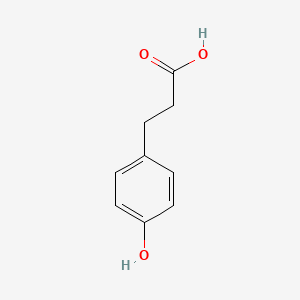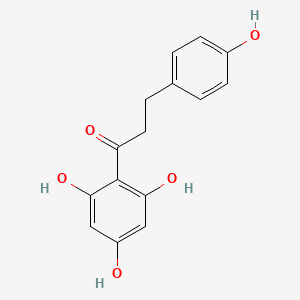
Phthalimidoamlodipin
Übersicht
Beschreibung
Pharmaceutical secondary standards for application in quality control provide pharma laboratories and manufacturers with a convenient and cost-effective alternative to the preparation of in-house working standards
Phthalimidoamlodipine is an impurity of Amlodipine --- a medication used to lower blood pressure and prevent chest pain.
Wissenschaftliche Forschungsanwendungen
Zwischenprodukt für die Amlodipin-Herstellung
Phthalimidoamlodipin ist ein nützliches Zwischenprodukt für die Herstellung von Amlodipin und seinen Salzen, die zur Behandlung von Bluthochdruck eingesetzt werden .
Synthese des Phthalimid-Kerns
Phthalimide, einschließlich this compound, sind ein privilegiertes Strukturmotiv, das häufig in Naturstoffen, Arzneimitteln und organischen Materialien vorkommt. Sie werden durch die Kondensation von Phthalsäuren/Anhydriden mit primären Aminen synthetisiert .
Wirkmechanismus
Target of Action
Phthalimidoamlodipine is an impurity of Amlodipine , a medication used to prevent chest pain and lower blood pressure . Amlodipine is a popular antihypertensive drug belonging to the group of drugs called dihydropyridine calcium channel blockers . These drugs are selective for the peripheral blood vessels, which are associated with a lower incidence of myocardial depression and cardiac conduction abnormalities than other calcium channel blockers .
Mode of Action
Amlodipine, and by extension Phthalimidoamlodipine, exerts its action directly on vascular smooth muscle to lead to a reduction in peripheral vascular resistance, causing a decrease in blood pressure . It has antioxidant properties and an ability to enhance the production of nitric oxide (NO), an important vasodilator that decreases blood pressure .
Biochemical Pathways
It is known that amlodipine and its derivatives act on the calcium channels in the vascular smooth muscle, leading to vasodilation and a decrease in blood pressure
Pharmacokinetics
Amlodipine, the parent compound, is well-absorbed with peak plasma concentrations reached 6-12 hours after oral administration . It is extensively (about 90%) converted to inactive metabolites via hepatic metabolism with 10% of the parent compound and 60% of the metabolites excreted in the urine . More research is needed to determine the ADME properties of Phthalimidoamlodipine and their impact on bioavailability.
Result of Action
It is known that amlodipine, the parent compound, acts as a peripheral arterial vasodilator and reduces blood pressure by acting directly on vascular smooth muscle
Action Environment
Environmental factors can influence the action, efficacy, and stability of many drugs, including Phthalimidoamlodipine. Factors such as diet, lifestyle, and exposure to other drugs or substances can affect how a person responds to a medication .
Biochemische Analyse
Biochemical Properties
Phthalimidoamlodipine plays a significant role in various biochemical reactions. It interacts with several enzymes, proteins, and other biomolecules. Notably, it has been observed to interact with cytochrome P450 enzymes, particularly CYP3A4, which is crucial for its metabolism . The nature of these interactions involves the inhibition of calcium ion influx through L-type calcium channels, similar to amlodipine, but with additional modulation due to the phthalimide group.
Cellular Effects
Phthalimidoamlodipine influences various cellular processes. It affects cell signaling pathways, particularly those involving calcium ions, which are vital for numerous cellular functions. This compound has been shown to alter gene expression related to calcium homeostasis and cellular metabolism . Additionally, it impacts cellular metabolism by modulating the activity of enzymes involved in metabolic pathways.
Molecular Mechanism
The molecular mechanism of phthalimidoamlodipine involves its binding to L-type calcium channels, leading to the inhibition of calcium ion influx. This action results in the relaxation of vascular smooth muscle cells, thereby reducing blood pressure . Furthermore, the phthalimide group may contribute to additional binding interactions with other biomolecules, enhancing its therapeutic effects.
Temporal Effects in Laboratory Settings
In laboratory settings, the effects of phthalimidoamlodipine have been observed to change over time. The compound exhibits stability under standard laboratory conditions, but its degradation products can influence long-term cellular functions. In vitro studies have shown that prolonged exposure to phthalimidoamlodipine can lead to sustained inhibition of calcium channels and persistent changes in gene expression .
Dosage Effects in Animal Models
The effects of phthalimidoamlodipine vary with different dosages in animal models. At therapeutic doses, it effectively reduces blood pressure without significant adverse effects. At higher doses, toxic effects such as hypotension and bradycardia have been observed . These findings highlight the importance of dosage optimization for safe and effective use.
Metabolic Pathways
Phthalimidoamlodipine is involved in several metabolic pathways. It is primarily metabolized by cytochrome P450 enzymes, particularly CYP3A4, leading to the formation of various metabolites . These metabolic pathways are crucial for the clearance of the compound from the body and can influence its therapeutic efficacy and safety profile.
Transport and Distribution
The transport and distribution of phthalimidoamlodipine within cells and tissues are mediated by specific transporters and binding proteins. It is distributed unevenly across different tissues, with higher concentrations observed in vascular tissues due to its affinity for calcium channels . This distribution pattern is essential for its pharmacological effects.
Subcellular Localization
Phthalimidoamlodipine is localized primarily in the cytoplasm and cell membrane, where it exerts its effects on calcium channels . The presence of targeting signals and post-translational modifications may direct it to specific cellular compartments, enhancing its functional activity.
Eigenschaften
IUPAC Name |
3-O-ethyl 5-O-methyl 4-(2-chlorophenyl)-2-[2-(1,3-dioxoisoindol-2-yl)ethoxymethyl]-6-methyl-1,4-dihydropyridine-3,5-dicarboxylate | |
|---|---|---|
| Source | PubChem | |
| URL | https://pubchem.ncbi.nlm.nih.gov | |
| Description | Data deposited in or computed by PubChem | |
InChI |
InChI=1S/C28H27ClN2O7/c1-4-38-28(35)24-21(15-37-14-13-31-25(32)17-9-5-6-10-18(17)26(31)33)30-16(2)22(27(34)36-3)23(24)19-11-7-8-12-20(19)29/h5-12,23,30H,4,13-15H2,1-3H3 | |
| Source | PubChem | |
| URL | https://pubchem.ncbi.nlm.nih.gov | |
| Description | Data deposited in or computed by PubChem | |
InChI Key |
AHHPZGUFLGCZCF-UHFFFAOYSA-N | |
| Source | PubChem | |
| URL | https://pubchem.ncbi.nlm.nih.gov | |
| Description | Data deposited in or computed by PubChem | |
Canonical SMILES |
CCOC(=O)C1=C(NC(=C(C1C2=CC=CC=C2Cl)C(=O)OC)C)COCCN3C(=O)C4=CC=CC=C4C3=O | |
| Source | PubChem | |
| URL | https://pubchem.ncbi.nlm.nih.gov | |
| Description | Data deposited in or computed by PubChem | |
Molecular Formula |
C28H27ClN2O7 | |
| Source | PubChem | |
| URL | https://pubchem.ncbi.nlm.nih.gov | |
| Description | Data deposited in or computed by PubChem | |
DSSTOX Substance ID |
DTXSID30893841 | |
| Record name | Phthalimidoamlodipine | |
| Source | EPA DSSTox | |
| URL | https://comptox.epa.gov/dashboard/DTXSID30893841 | |
| Description | DSSTox provides a high quality public chemistry resource for supporting improved predictive toxicology. | |
Molecular Weight |
539.0 g/mol | |
| Source | PubChem | |
| URL | https://pubchem.ncbi.nlm.nih.gov | |
| Description | Data deposited in or computed by PubChem | |
CAS No. |
88150-62-3 | |
| Record name | Phthaloylamlodipine | |
| Source | CAS Common Chemistry | |
| URL | https://commonchemistry.cas.org/detail?cas_rn=88150-62-3 | |
| Description | CAS Common Chemistry is an open community resource for accessing chemical information. Nearly 500,000 chemical substances from CAS REGISTRY cover areas of community interest, including common and frequently regulated chemicals, and those relevant to high school and undergraduate chemistry classes. This chemical information, curated by our expert scientists, is provided in alignment with our mission as a division of the American Chemical Society. | |
| Explanation | The data from CAS Common Chemistry is provided under a CC-BY-NC 4.0 license, unless otherwise stated. | |
| Record name | Phthalimidoamlodipine | |
| Source | ChemIDplus | |
| URL | https://pubchem.ncbi.nlm.nih.gov/substance/?source=chemidplus&sourceid=0088150623 | |
| Description | ChemIDplus is a free, web search system that provides access to the structure and nomenclature authority files used for the identification of chemical substances cited in National Library of Medicine (NLM) databases, including the TOXNET system. | |
| Record name | Phthalimidoamlodipine | |
| Source | EPA DSSTox | |
| URL | https://comptox.epa.gov/dashboard/DTXSID30893841 | |
| Description | DSSTox provides a high quality public chemistry resource for supporting improved predictive toxicology. | |
| Record name | 3-ethyl 5-methyl 4-(2-chlorophenyl)-1,4-dihydro-2-[2-(1,3-dihydro-1,3-dioxo-(2H)isoindol-2-yl)-ethoxymethyl]-6-methyl-3,5-pyridinedicarboxylate | |
| Source | European Chemicals Agency (ECHA) | |
| URL | https://echa.europa.eu/substance-information/-/substanceinfo/100.101.265 | |
| Description | The European Chemicals Agency (ECHA) is an agency of the European Union which is the driving force among regulatory authorities in implementing the EU's groundbreaking chemicals legislation for the benefit of human health and the environment as well as for innovation and competitiveness. | |
| Explanation | Use of the information, documents and data from the ECHA website is subject to the terms and conditions of this Legal Notice, and subject to other binding limitations provided for under applicable law, the information, documents and data made available on the ECHA website may be reproduced, distributed and/or used, totally or in part, for non-commercial purposes provided that ECHA is acknowledged as the source: "Source: European Chemicals Agency, http://echa.europa.eu/". Such acknowledgement must be included in each copy of the material. ECHA permits and encourages organisations and individuals to create links to the ECHA website under the following cumulative conditions: Links can only be made to webpages that provide a link to the Legal Notice page. | |
| Record name | 3,5-Pyridinedicarboxylic acid, 4-(2-chlorophenyl)-2-[[2-(1,3-dihydro-1,3-dioxo-2H-isoindol-2-yl)ethoxy]methyl]-1,4-dihydro-6-methyl-, 3-ethyl 5-methyl ester | |
| Source | European Chemicals Agency (ECHA) | |
| URL | https://echa.europa.eu/information-on-chemicals | |
| Description | The European Chemicals Agency (ECHA) is an agency of the European Union which is the driving force among regulatory authorities in implementing the EU's groundbreaking chemicals legislation for the benefit of human health and the environment as well as for innovation and competitiveness. | |
| Explanation | Use of the information, documents and data from the ECHA website is subject to the terms and conditions of this Legal Notice, and subject to other binding limitations provided for under applicable law, the information, documents and data made available on the ECHA website may be reproduced, distributed and/or used, totally or in part, for non-commercial purposes provided that ECHA is acknowledged as the source: "Source: European Chemicals Agency, http://echa.europa.eu/". Such acknowledgement must be included in each copy of the material. ECHA permits and encourages organisations and individuals to create links to the ECHA website under the following cumulative conditions: Links can only be made to webpages that provide a link to the Legal Notice page. | |
| Record name | PHTHALIMIDOAMLODIPINE | |
| Source | FDA Global Substance Registration System (GSRS) | |
| URL | https://gsrs.ncats.nih.gov/ginas/app/beta/substances/9QAO5CRP93 | |
| Description | The FDA Global Substance Registration System (GSRS) enables the efficient and accurate exchange of information on what substances are in regulated products. Instead of relying on names, which vary across regulatory domains, countries, and regions, the GSRS knowledge base makes it possible for substances to be defined by standardized, scientific descriptions. | |
| Explanation | Unless otherwise noted, the contents of the FDA website (www.fda.gov), both text and graphics, are not copyrighted. They are in the public domain and may be republished, reprinted and otherwise used freely by anyone without the need to obtain permission from FDA. Credit to the U.S. Food and Drug Administration as the source is appreciated but not required. | |
Synthesis routes and methods I
Procedure details





Synthesis routes and methods II
Procedure details






Synthesis routes and methods III
Procedure details





Retrosynthesis Analysis
AI-Powered Synthesis Planning: Our tool employs the Template_relevance Pistachio, Template_relevance Bkms_metabolic, Template_relevance Pistachio_ringbreaker, Template_relevance Reaxys, Template_relevance Reaxys_biocatalysis model, leveraging a vast database of chemical reactions to predict feasible synthetic routes.
One-Step Synthesis Focus: Specifically designed for one-step synthesis, it provides concise and direct routes for your target compounds, streamlining the synthesis process.
Accurate Predictions: Utilizing the extensive PISTACHIO, BKMS_METABOLIC, PISTACHIO_RINGBREAKER, REAXYS, REAXYS_BIOCATALYSIS database, our tool offers high-accuracy predictions, reflecting the latest in chemical research and data.
Strategy Settings
| Precursor scoring | Relevance Heuristic |
|---|---|
| Min. plausibility | 0.01 |
| Model | Template_relevance |
| Template Set | Pistachio/Bkms_metabolic/Pistachio_ringbreaker/Reaxys/Reaxys_biocatalysis |
| Top-N result to add to graph | 6 |
Feasible Synthetic Routes
Haftungsausschluss und Informationen zu In-Vitro-Forschungsprodukten
Bitte beachten Sie, dass alle Artikel und Produktinformationen, die auf BenchChem präsentiert werden, ausschließlich zu Informationszwecken bestimmt sind. Die auf BenchChem zum Kauf angebotenen Produkte sind speziell für In-vitro-Studien konzipiert, die außerhalb lebender Organismen durchgeführt werden. In-vitro-Studien, abgeleitet von dem lateinischen Begriff "in Glas", beinhalten Experimente, die in kontrollierten Laborumgebungen unter Verwendung von Zellen oder Geweben durchgeführt werden. Es ist wichtig zu beachten, dass diese Produkte nicht als Arzneimittel oder Medikamente eingestuft sind und keine Zulassung der FDA für die Vorbeugung, Behandlung oder Heilung von medizinischen Zuständen, Beschwerden oder Krankheiten erhalten haben. Wir müssen betonen, dass jede Form der körperlichen Einführung dieser Produkte in Menschen oder Tiere gesetzlich strikt untersagt ist. Es ist unerlässlich, sich an diese Richtlinien zu halten, um die Einhaltung rechtlicher und ethischer Standards in Forschung und Experiment zu gewährleisten.


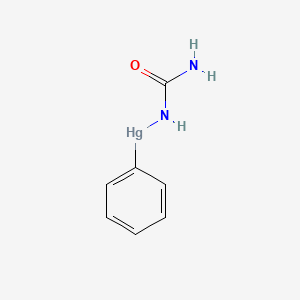
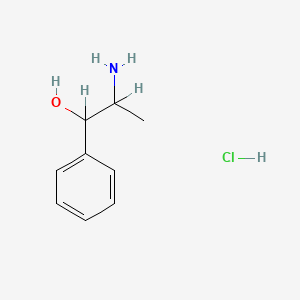

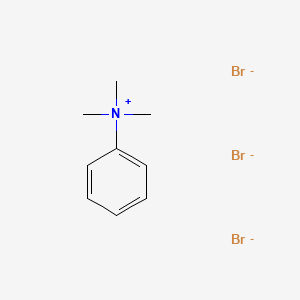
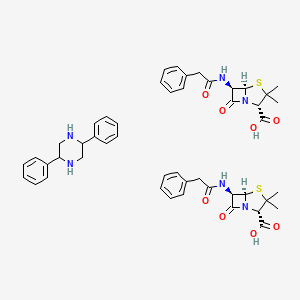
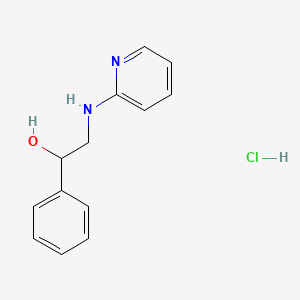
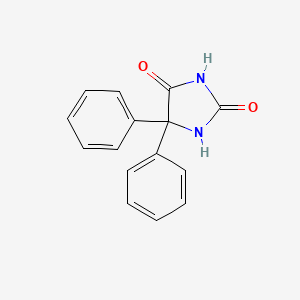
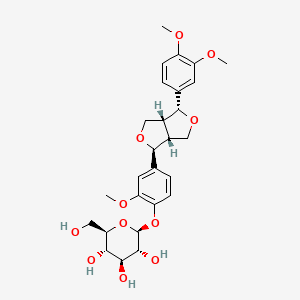
![2-Amino-1-methyl-6-phenylimidazo[4,5-b]pyridine](/img/structure/B1677688.png)
![2-[2-[2-[[2-[[4-[[2-[[6-amino-2-[3-amino-1-[(2,3-diamino-3-oxopropyl)amino]-3-oxopropyl]-5-methylpyrimidine-4-carbonyl]amino]-3-[3-[4-carbamoyl-3,4,5-trihydroxy-6-(hydroxymethyl)oxan-2-yl]oxy-4,5-dihydroxy-6-(hydroxymethyl)-3-methyloxan-2-yl]oxy-3-(1H-imidazol-5-yl)propanoyl]amino]-3-hydroxy-2-methylpentanoyl]amino]-3-oxobutanoyl]amino]ethyl]-4,5-dihydro-1,3-thiazol-4-yl]-1,3-thiazole-4-carboxamide](/img/structure/B1677689.png)
